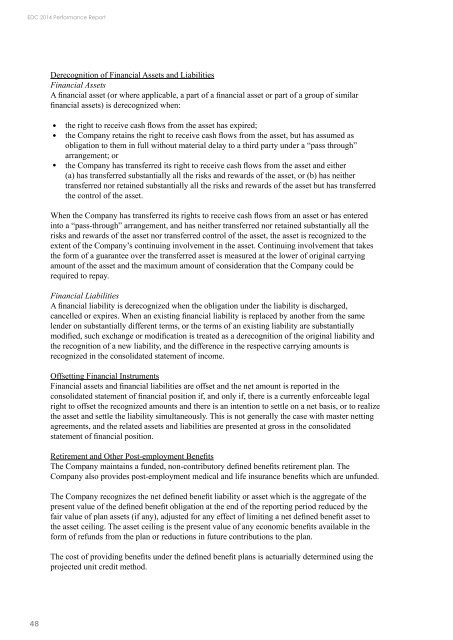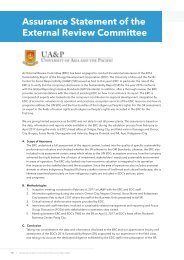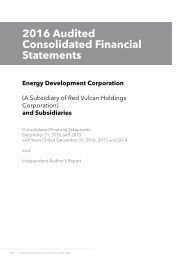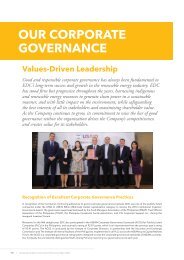2014 Financial Statement
You also want an ePaper? Increase the reach of your titles
YUMPU automatically turns print PDFs into web optimized ePapers that Google loves.
EDC <strong>2014</strong> Performance Report<br />
Derecognition of <strong>Financial</strong> Assets and Liabilities<br />
<strong>Financial</strong> Assets<br />
A financial asset (or where applicable, a part of a financial asset or part of a group of similar<br />
financial assets) is derecognized when:<br />
the right to receive cash flows from the asset has expired;<br />
the Company retains the right to receive cash flows from the asset, but has assumed as<br />
obligation to them in full without material delay to a third party under a “pass through”<br />
arrangement; or<br />
the Company has transferred its right to receive cash flows from the asset and either<br />
(a) has transferred substantially all the risks and rewards of the asset, or (b) has neither<br />
transferred nor retained substantially all the risks and rewards of the asset but has transferred<br />
the control of the asset.<br />
When the Company has transferred its rights to receive cash flows from an asset or has entered<br />
into a “pass-through” arrangement, and has neither transferred nor retained substantially all the<br />
risks and rewards of the asset nor transferred control of the asset, the asset is recognized to the<br />
extent of the Company’s continuing involvement in the asset. Continuing involvement that takes<br />
the form of a guarantee over the transferred asset is measured at the lower of original carrying<br />
amount of the asset and the maximum amount of consideration that the Company could be<br />
required to repay.<br />
<strong>Financial</strong> Liabilities<br />
A financial liability is derecognized when the obligation under the liability is discharged,<br />
cancelled or expires. When an existing financial liability is replaced by another from the same<br />
lender on substantially different terms, or the terms of an existing liability are substantially<br />
modified, such exchange or modification is treated as a derecognition of the original liability and<br />
the recognition of a new liability, and the difference in the respective carrying amounts is<br />
recognized in the consolidated statement of income.<br />
Offsetting <strong>Financial</strong> Instruments<br />
<strong>Financial</strong> assets and financial liabilities are offset and the net amount is reported in the<br />
consolidated statement of financial position if, and only if, there is a currently enforceable legal<br />
right to offset the recognized amounts and there is an intention to settle on a net basis, or to realize<br />
the asset and settle the liability simultaneously. This is not generally the case with master netting<br />
agreements, and the related assets and liabilities are presented at gross in the consolidated<br />
statement of financial position.<br />
Retirement and Other Post-employment Benefits<br />
The Company maintains a funded, non-contributory defined benefits retirement plan. The<br />
Company also provides post-employment medical and life insurance benefits which are unfunded.<br />
The Company recognizes the net defined benefit liability or asset which is the aggregate of the<br />
present value of the defined benefit obligation at the end of the reporting period reduced by the<br />
fair value of plan assets (if any), adjusted for any effect of limiting a net defined benefit asset to<br />
the asset ceiling. The asset ceiling is the present value of any economic benefits available in the<br />
form of refunds from the plan or reductions in future contributions to the plan.<br />
The cost of providing benefits under the defined benefit plans is actuarially determined using the<br />
projected unit credit method.<br />
48
















